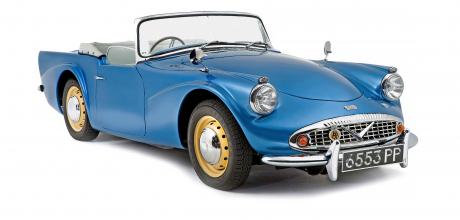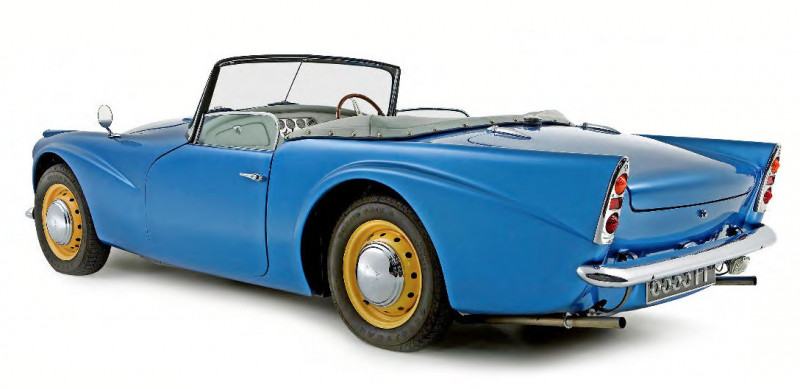Buying Guide Daimler SP250

Overlooked for decades, this charming Daimler roadster makes acost-effective alternative to an early Jaguar E-type – for now
Words JAMES WALSHE
Photography JOHN COLLEY
Buying Guide Take a look at the innovative Daimler SP250 while it’s still a great value buy
What to pay
- There is no real difference between A-, B- and C-spec cars in terms of value. Although A-specs are regarded as lighter and purer, unresolved handling issues mean B- and C-spec cars are better to drive, cancelling out any advantage, and A-specs are often upgraded to B-spec chassis anyway.
- £14,000 will buy a project car with a rusty chassis, smoky engine and cracked bodywork. Good scruffy runners with plenty of service history start at £20,000, rising to £25,000 for an excellent privately-sold A-spec.

Now is probably a good time to buy a Daimler SP250. They’re no longer the absolute bargains they used to be, but this is good news because it means they’re getting restored and the examples on the market tend to be in good condition.
Its looks have always been considered challenging, but they’ve mellowed with time. Forget the styling and look at what you get: launched just before Jaguar bought Daimler, the SP250 featured several advanced features, such as four-wheel disc brakes, glassfibre bodyshell, a chassis devised by John Box, the man who later made V8 TVRs handle, and a 2.5-litre hemi-V8 engine from Ariel and Triumph motorcycle engineer Edward Turner. It’s a sophisticated car, more advanced than a contemporary Jaguar XK150.
To guide us towards an excellent example of the SP250, we’ve turned to Robert Grinter, the UK’s only dedicated SP250 restoration specialist, and source of several reproduction and repair parts.
Which one to choose?
After launching the car as the ‘Dart’ at the 1959 New York Auto Show, Daimler got into trouble with Chrysler, which had already registered the name as a Dodge model. Officially therefore, the name was changed to SP250, in reference to the 2.5-litre engine.
After Jaguar bought the company in 1960, its engineers didn’t much care for the Daimler’s considerable chassis flex, so released a strengthened version of the SP250 known as the ‘B-spec’ in 1961, with a stronger rear axle too. An automatic gearbox became an option, and a longer-range fuel tank was fitted. The model lost the chrome ‘whiskers’ around the front indicators at this time too, although chrome bumpers with angular overriders were fitted as standard.
The Police used SP250s as motorway patrol cars, several of which are now in civilian hands. Daimler supplied them with ‘Police-spec’ cars from 1961. These are B-spec models with a revised automatic gearbox allowing the car to hold second gear all the way to 100mph.
The ‘C-spec’ variant arrived in 1963, but this just referred to the addition of a cigarette lighter and built-in trickle-charger socket. The huge success of the E-type (plus the fact that the SP250 was, technically, a rival) ensured the demise of the Daimler SP250 in 1964 after just 2645 had rolled off the production line. Of those, 1445 were right-hand drive.
Bodyshell
Don’t assume that the glassfibre body is immune to the effects of weather and ageing. These cars are now 60 years old after all, so crazing and other forms of deterioration aren’t uncommon. Addressing a small crack may cost £500-£600 including a localised respray. However, it’s also worth checking for shoddy repairs; raised lines under the paint point to an accident repair done in a hurry, and stripping, repairing and properly respraying a whole glassfibre bodyshell can run to £12,000. The good news is that once you have sorted out the bodywork, so long as you keep the car in good shape, you’ll probably never have to do anything to it again.
Chassis
B-spec cars onwards have slightly altered chassis, most notably a beam beneath the windscreen, but the points to check are largely the same across all specifications of SP250. The cross tubes across the front and below the radiator are very susceptible to corrosion, while the sill beams can also be problematic. Suspension turrets can rust too and check the two U-shaped crossmembers at the rear – they are often bent after being used as a jacking point.
While entire replacement chassis are unavailable, Robert Grinter has reproduced the localised sections most prone to rust, which can be welded in. However, the cost of repairing a thoroughly rotten chassis and protecting it against future corrosion can run to in excess of £4000.
Engine
Engines may smoke upon starting up, because valve stem seals weren’t fitted originally. However, persistently heavy smokers will probably have worn piston rings, cylinder bores or both. Also, after the engine has warmed up, look for an oil pressure reading of 40psi, dropping to 20psi at idle.

Cylinder heads can corrode both on the decks and from inside the galleries, and specialised aluminium welding will almost certainly be needed on units that have been untouched up to now. Exchange ’heads are available from specialists, however. A full engine rebuild can run to £6000.
A few late C-spec SP250s were fitted with alternators, but the vast majority stuck with dynamos, which can struggle to provide power at low revs. You only need to fit a 12v outlet or upgrade headlamps to find that the dynamo doesn’t cut it when you reach your first traffic jam.
Gearbox
The four-speed manual has synchromesh on the top three forward ratios. A chattering noise in first can signal a worn first layshaft gear, but could also be a pricier first main shaft gear. Either way, a rebuild will be over £1000. The optional three-speed Borg-Warner auto is generally robust, but the internal layout is unusual with a two-speed gearcase and third provided through the torque converter. Pulling away in second is normal, but the unit needs attention if it shows a reluctance to shift gear without backing off the throttle. The biggest enemies of the rear axle are age and poor servicing – listen out for differential whine.
Suspension, steering and brakes
Original rear semi-elliptical leaf springs may need replacing. Inspect the rear lever-arm dampers for leaks; replacements cost £150 exchange each. The front suspension comprises upper and lower wishbones with stub axles bolted through a vertical link. These links have trunnions at the bottom that can be replaced if worn, but if the link itself is damaged an exchange item will set you back about £1600. The handbrake lever on the rear hubs wears and can move forward and aft by as much as two inches, as well as chattering loudly when driving.
There’s a three-way brake union at the rear and a five-way at the front. You’ll want to think about changing them from alloy to brass if the job hasn’t already been done, which is also likely to involve re-piping the whole car.
The Daimler’s steering box was quite normal for a late Fifties design, but is loose by the standard of cars even just a decade newer. Rack-and-pinion conversions are commonplace, with Triumph Spitfire set-ups the generally favoured choice.
Interior
Interiors look opulent, with plenty of leather, but are actually relatively simple things, and replacement parts are readily available. A full retrim, including hood, runs to £6000.
‘So long as you buy one in good condition and maintain it, running costs can be kept low’
V8’s list of common issues is thankfully short; a rebuild will cost £6000
Luxury interior doesn’t pose any particular parts-sourcing problems
Sponsored by Carole Nash Insurance
‘The Daimler SP250 is a unique car not only for it looks but also it’s back story,’ says Peter McIlvenny of Carole Nash Insurance. ‘In my opinion time has been kind, and the Dart possesses an individuality you just don’t see in modern cars. But which to buy? You would expect any cars for sale to be “B-Spec” and retrofitted with the appropriate improvements but always check. And although the body is glassfibre, it’s worth checking that the paintwork is not cracking, or showing the potential to. In terms of values, these are solid investments that won’t be heading skywards in the next ten years but won’t seriously let you down either.
Classic car insurance quotes: 0333 005 7541 or carolenash.com 1961 Daimler SP250 B-Spec — £54,995 One family owned from 1963-2010. Bought in 2015 by a retired prewar car restorer who fitted with stronger full synchro overdrive gearbox from the V8 250 saloon, Austin-Healey 3000 diaphram clutch, and shortened, rebuilt and balanced the propshaft. In 2017 it was repainted in its original Cream. New mohair hood and boot carpet, new mohair tonneau cover, refurbished hard top. Interior retrimmed to a beautiful standard.
Owning a Daimler SP250
Graham Instrell
‘I remember SP250s vividly from my youth,’ says Graham Instrell, ‘but decided to buy one after seeing one on track at the Goodwood Revival. I got mine in 2016 and, to be honest, I’ve never had to do any major work on it because the previous owner restored it back in 1999. Luckily he did a great job because it’s still in extremely good condition today.
‘Parts are readily available and I do the annual servicing myself. It’s just a case of popping it up on an inspection ramp and everything is accessible. I wouldn’t say it’s any more difficult to maintain than other classic cars of this type and era – so long as you buy one in good condition and maintain it, running costs can be kept relatively low.
‘The driving experience is all about the V8, for me. You can cruise around all day in top gear – it’s such a brilliant engine, you rarely need to change gear! It shows its age in other ways though. The steering is heavy at parking speed for instance.
‘It’s not the most practical of classics, I suppose. I also have a Porsche 928 – similar appeal with its big lazy V8 engine — and tend to use it a lot more. But the Daimler comes out when the sun shines. It is a brilliant car for summer cruising. ‘It’s definitely a keeper. I’m a member of the superb Daimler and Lanchester Owner’s Club. There’s a dedicated group for SP250 owners, so we are well catered for by specialists and fellow enthusiasts. There is a great magazine too, which provides some very useful information and experience. Plus, of course, a great bunch of people to spend time with!’
‘It’s sophisticated, more advanced than an XK150’

